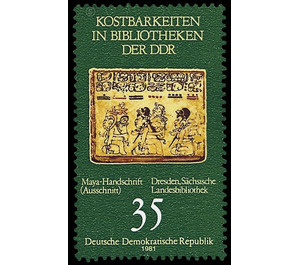Treasures in libraries of the GDR - Germany / German Democratic Republic 1981 - 35 Pfennig
Theme: Architecture
| Country | Germany / German Democratic Republic |
| Issue Date | 1981 |
| Face Value | 35.00 |
| Color | green |
| Perforation | K 14 |
| Printing Type | Rotogravure 2 |
| Stamp Type | Postage stamp |
| Item Type | Stamp |
| Chronological Issue Number | 2379 |
| Chronological Chapter | GER-DDR |
| SID | 799923 |
| In 14 Wishlists | |
Treasures in libraries of the GDR With the illustrations of treasures in libraries of the GDR, the Ministry of Posts and Telecommunications of the German Democratic Republic publishes three multicolored special postage stamps. Special cancellations from 18 August to 17 October 1981 Treasures in libraries of the GDR From 17 to 22 August 1981, the 47th session of the General Assembly of the International Federation of Library Associations and Institutions (IFLA) will be held in Leipzig with the general theme "National Institutions and professional organizations of the library ". The conference will be preceded by a one-week IFLA / UNESCO seminar for librarians from developing countries. Founded in 1927, IFLA is one of the largest and most influential international non-governmental organizations in the field of culture, education and science with A status at UNESCO. The IFLA currently has about 950 members. President since 1979 Else Granheim (Norway). The library association of the GDR has been a member of the IFLA since 1964. All European socialist fraternal countries are also represented in this organization. 35-pfennig value: Mayan manuscript; Detail The Mayan manuscript, Codex Dresdensis, is the property of the Saxon State Library Dresden. Discovered in Vienna and bought for the then Electoral Library Dresden in 1739 by the librarian J. Chr. Götze. It is not known exactly how the manuscript came to Vienna, presumably because of the tight ties of the ruling houses in Vienna and Madrid. It is a handwriting from Central America painted on fig tree fiber. The folding book, consisting of 39 pages described on both sides, is 20.5 cm high and 9 cm wide. Document from the 16th century of Mayan culture lost as a result of the European conquests. Originally written in the 12th to 13th centuries, the manuscript probably dates back to an original from the 8th century. The Codex-Dresdensis is one of the three preserved painted manuscripts of the Mayan Indians. In contrast to the copies with other contents kept in the National Library of Paris and in the National Museum in Madrid, the Dresden manuscript is considered the most beautiful and oldest. The Codex Dresdensis contains a mythological-astronomical calendar. Examples of the high level of Mayan learning, especially for the Mayan calendar system developed and its astronomical knowledge, which served primarily magical-religious and cult purposes. The Codex-Dresdensis is explained with certainty regarding its calendar elements, the numerous characters are clarified up to 3/4. The panel (sheet 20) lower part of the manuscript shows a pictorial representation of a series of hyroglyphs, a number series and three female figures in symbolic representations.


